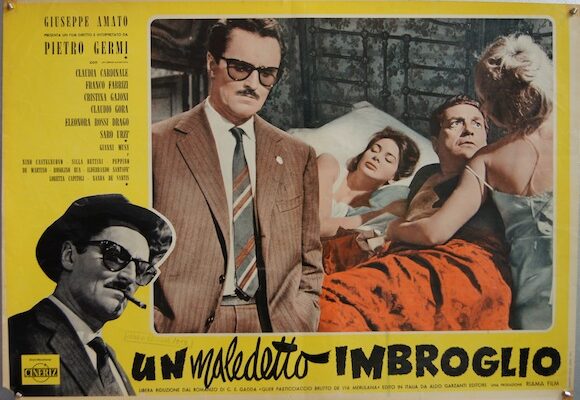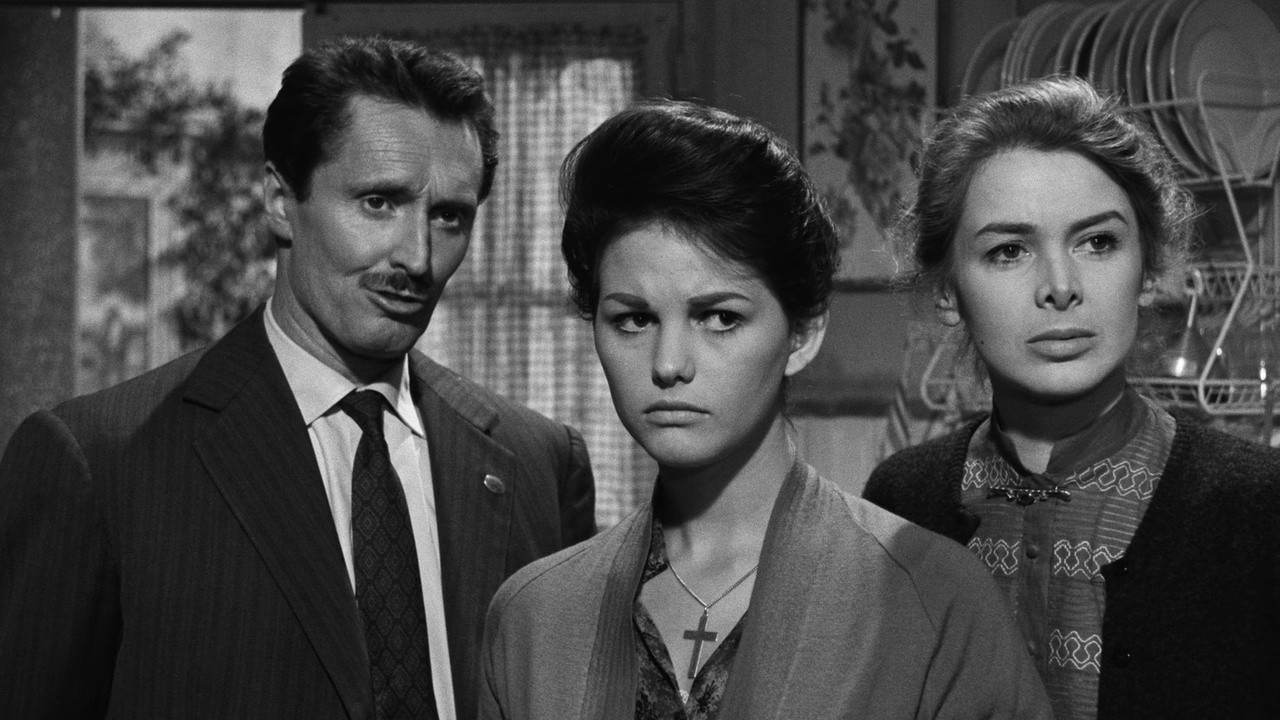Un Maledetto Imbroglio [The Facts of Murder] (1959)

Toronto Film Society presented Un Maledetto Imbroglio [The Facts of Murder] (1959) on Sunday, August 17, 2025 as part of the Season 77 Series, Programme 10.
Production Company: Riama Film. Produced by: Giuseppe Amato, Mario Silvestri. Directed by: Pietro Germi. Screenplay by: Pietro Germi, Ennio De Concini, Alfredo Giannetti, based on the novel That Awful Mess on Via Merulana by Carlo Emilio Gadda. Cinematography: Leonida Barboni. Editing: Roberto Cinquini. Music by: Carlo Rustichelli. Running time: 115 minutes.
Cast: Pietro Germi (Inspector Ingravallo), Claudia Cardinale (Assuntina Jacovacci), Franco Fabrizi (Massimo Valdarena), Cristina Gaioni (Virginia), Claudio Gora (Remo Banducci), Eleonora Rossi Drago (Liliana Banducci), Saro Urzì (Detective Saro), Nino Castelnuovo (Diomede), Ildebrando Santafé (Anzaloni).

What are The Facts of Murder (the English title of our 1959 movie), and what do they tell us about Rome society in this case? Or is it all ‘a damned mess’, (as the original Italian film title Un Maledetto Imbroglio) implies?
As we saw in TFS’s previously shown UK film Sapphire (also from 1959), a murder mystery can do more than entertain – it can expose the tensions simmering beneath society’s surface. In this moody, atmospheric Italian film, with its richly textured cinematography and a haunting love song over the opening credits, we’re taken on a journey through Rome’s social strata – from the struggling lower class to the polished elite—and much of what we see isn’t very pretty.
The twisty screenplay was adapted from Carlo Emilio Gadda’s 1957 novel, translated in 1965 as That Awful Mess on the Via Merulana. Two crimes in nearby apartments: A robbery in one, and the subsequent murder of an elegant housewife (Eleanora Rossi Drago), in another. The cigar-smoking police inspector (played by director Pietro Germi), and his crew are led down many false avenues.
Why had the lady recently changed her will?
Among the suspects: The philandering husband (Claudio Gora); the victim’s suave but nervous cousin (Franco Fabrizi); as well as the beautiful maid (Claudia Cardinale), and her handsome boyfriend (Nino Castelnuovo). Is each person hiding a secret – some more sordid than others? And do their alibis really hold up?
Movies set in the city have certainly changed from World War II to this 2025 Jubilee Year (Holy Year) currently being celebrated in Rome.
Roberto Rossellini’s Rome Open City (Roma Città Aperta) (1945) filmed at war’s end, with Anna Magnani, and other neo-realist films, showed us the horrors of the Nazi-occupation, and wide-spread poverty. Afterwards, Hollywood made more escapist movies such as Roman Holiday (1953) with Gregory Peck and Audrey Hepburn, and the touristy Three Coins in the Fountain (1954).
Other post-war Italian directors, apart from Rossellini, became famous on the art-house movie circuit, and even became somewhat well-known to the general public. Among them: Vittorio De Sica; Federico Fellini; Luchino Visconti; and Michelangelo Antonioni.
Opinions are divided as to where Pietro Germi (1914-1974) fits in the pantheon. Yet, there seems to be agreement that he has been underestimated till recently. Germi directed almost 20 films (from 1946 on) in many genres with top actors and also wrote the screenplay and /or acted in some of them.
However, he was later best known for his worldwide satirical hits on Sicilian morality – Divorce Italian Style (Divorzio all’Italiana) (1961) with Marcello Mastroianni, for which he won the 1962 Best Original Screenplay Oscar, (as well as a nomination as Best Director) and Seduced and Abandoned (Sedotta e Abbandonata) (1964).
The very term ‘Italian-style comedy’ (‘commedia all’Italiana’) was inspired by the ’61 film, which lampooned Italy’s antiquated divorce laws! Germi’s last film was Alfredo, Alfredo (1972), with Dustin Hoffman.
The Cast
Eleanora Rossi Drago (1925-2007), a popular star of the 1950s, was noted for her sensual appeal, but also critically applauded for such roles as in Valerio Zurlini’s Violent Summer (Estate Violenta) (1959), and the leading role in Antonioni’s Le Amiche (also The Girlfriends) (1955). One of their boyfriends was Franco Fabirizi. Franco Fabrizi (1916-1995), with over 100 credits including several Fellini films. was unforgettable as the main ladies’ man in that director’s I Vitelloni (1953). Neither star seemed to pursue a Hollywood career, though they worked with US-UK actors on occasion.
Although Nino Castelnuovo, (1936-2021) did do some English-language co-produced movies, he is more famous for his Italian and French movies, and TV shows. His best-known role was one of the star-crossed lovers, opposite Catherine Deneuve, in Jacques Demy’s acclaimed The Umbrellas of Cherbourg (Les Parapluies de Cherbourg) (1964).
One of this movie’s only major stars still living, Claudia Cardinale (born 1938), soon had a breakout year in 1960 in the title role of Zurlini’s The Girl with a Suitcase (La Ragazza con la Valigia), playing a wayward young woman trying to reclaim her life. This helped launch a worldwide career with such international co-productions as Visconti’s The Leopard (Il Gattopardo), with Burt Lancaster and Alain Delon, and Fellini’s 8 1/2 (Otto e Mezzo) (both 1963), with Mastroianni.
Early Hollywood and British movies such as Blake Edward’s The Pink Panther (1963) opposite David Niven and Peter Sellers, and Henry Hathaway’s Circus World (1964) with John Wayne and Rita Hayworth, led to many others. In that sense, she followed the international breakthroughs of Magnani, Gina Lollobrigida, Sophia Loren, and others (although all were often typecast in sex symbol roles).
The Facts of Murder‘s screenplay (1959) seemed to predict certain themes in at least two 1960 classics – Visconti’s Rocco and his Brothers (Rocco e Suoi Fratelli), in showing poor country people moving to the big city for work. (albeit that movie showed southerners moving to Milan); one character’s gigolo-like behavior with wealthy foreign tourists was repeated by the jet set in Fellini’s La Dolce Vita.
Movies about Rome itself have continued to be a source of fascination. The 2013 A Great Beauty (La Grande Bellezza) won the Oscar for Best International Film. Conclave (2024), a fictional but timely story about the election of a new Pope, was a fortuitous lead-up to this Jubilee Year.
Just as Rome remains eternal, one can only hope that filmmakers will continue to capture its spirit, in all its beauty, complexity, and contradictions, for generations to come.
Notes by David Marigold

Sunday Afternoons at the Paradise
Join TFS for Season 78’s Sunday Matinée Series generously sponsored by our good friend, author and documentary filmmaker, Mr. Don Hutchison. Please save these dates and visit us regularly...







